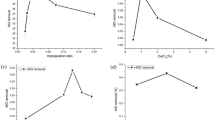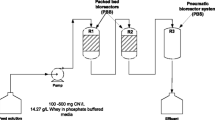Abstract
Immobilized form of Serratia marcescens strain AQ07 was experimented for cyanide biodegradation. Cyanide degradation (200 ppm) was achieved after 24-h incubation. Three parameters were optimized which included gellan gum concentration, beads size, and number of beads. In accordance with one-factor-at-a-time method, cyanide removal was optimum at 0.6% w/v gellan gum gel, 0.3-cm-diameter beads, and 50 beads number. It was able to withstand cyanide toxicity of 800 ppm, which makes it very suitable candidate in cyanide remediation. Beads reusability indicates one-cycle ability. The first cycle removed 96.3%, while the second removed 78.5%. Effects of heavy metals at 1.0 ppm demonstrated that mercury has a considerable effect on bacteria, inhibiting degradation to 61.6%, while other heavy metals have less effect, removing 97–98%. Maximum specific degradation rate of 0.9997 h−1 was observed at 200 ppm cyanide concentration. Gellan gum was used as the encapsulation matrix. ɤ-picoline-barbituric acid spectrophotometric analytical method was used to optimize the condition in buffer medium integrated with potassium cyanide via one-factor-at-a-time and response surface method. The range of cyanide concentrations used in this research, specific biodegradation rate was obtained to model the substrate inhibition kinetics. This rate fits to the kinetic models of Teisser, Aiba and Yano, which are utilized to elucidate substrate inhibition on degradation. One-factor-at-a-time approach parameters were adopted because it removes more cyanide compared to response surface methodology modules. The predicted biokinetic constant from this model suggests suitability of the bacteria for use in cyanide treatment of industrial waste effluents.








Similar content being viewed by others
References
Aiba S, Shoda M, Nagatani M (1968) Kinetics of product inhibition in alcohol fermentation. Biotechnol Bioeng 10: 845–864
Ahmad SA, Shamaan NA, Arif NM, Koon GB, Shukor MY, Syed MA (2012) Enhanced phenol degradation by immobilized Acinetobacter sp. strain AQ5NOL 1. World J Microbiol Biotechnol 28(1):347–352
Alzubaidy SK (2012) The resistance of locally isolated Serratia marcescens to heavy metals chlorides and optimization of some environmental factors. J Environ Occup Sci 1(1):37–42
Ashtaputre AA, Shah AK (1995) Studies on a viscous, gel-forming exopolysaccharide from Sphingomonas paucimobilis GS1. Appl Environ Microbiol 61(3):1159–1162
Basheer S, Kut Ö, Prenosil JE, Bourne JR (1992) Kinetics of enzymatic degradation of cyanide. Biotechnol Bioeng 39(6):629–634
Buitelaar RM, Hulst AC, Tramper J (1988) Immobilization of biocatalysts in thermogels using the resonance nozzle for rapid drop formation and an organic solvent for gelling. Biotechnol Tech 2(2):109–114
Camelin I, Lacroix C, Paquin C, Prevost H, Cachon R, Divies C (1993) Effect of chelatants on gellan gum rheological properties and setting temperature for immobilization of living bifidobacteria. Biotechnol Prog 9(3):291–297
Chen CY, Kao CM, Chen SC (2008) Application of Klebsiella oxytoca immobilized cells on the treatment of cyanide wastewater. Chemosphere 71(1):133–139
Chena S-C, Liu J-K (1999) The respiratory responses to cyanide of a cyanide-resistant Klebsiella oxytoca bacterial strain. FEMS Microbiol Lett 175(1):37–43
Dey S, Mukherjee S (2010) Performance and kinetic evaluation of phenol biodegradation by mixed microbial culture in a batch reactor. Int J Water Resour Environ Eng 2(3):40–49
Dursun AY, Aksu Z (2000) Biodegradation kinetics of ferrous (II) cyanide complex ions by immobilized Pseudomonas fluorescens in a packed bed column reactor. Process Biochem 35(6):615–622
Dursun AY, Tepe O (2005) Internal mass transfer effect on biodegradation of phenol by Ca-alginate immobilized Ralstonia eutropha. J Hazard Mater 126(1):105–111
Gurbuz F, Ciftci H, Akcil A (2009) Biodegradation of cyanide containing effluents by Scenedesmus obliquus. J Harzad Mater 162(1):74–79
Idriss AA, Ahmad AK (2014) Concentration of selected heavy metals in water of the Juru River, Penang, Malaysia. Afr J Biotechnol 11(33):8234–8240
Karamba K, Syed M, Shukor M, Ahmad SA (2014) Effect of heavy metals on cyanide biodegradation by resting cells of Serratia marcescens strain AQ07. J Environ Microbiol Toxicol 2(2):17–20
Karamba KI, Shukor MY, Syed MA, Zulkharnain A, Adeela N, Yasid AK, Khalil KA, Ahmad SA (2015a) Isolation, screening and characterisation of cyanide-degrading Serratia marcescens strain AQ07. J Chem Pharm Sci 8(2):401–406
Karamba KI, Syed MA, Shukor MY, Ahmad SA (2015b) Biological remediation of cyanide: a review. Biotropia 22(2):151–163
Karamba KI, Ahmad SA, Zulkharnain A, Syed MA, Khalil KA, Shamaan NA, Dahalan FA, Shukor MY (2016) Optimisation of biodegradation conditions for cyanide removal by Serratia marcescens strain AQ07 using one-factor-at-a-time technique and response surface methodology. Rendiconti Lincei 27(3):533–545
Kjeldsen P (1999) Behaviour of cyanides in soil and groundwater: a review. Water Air Soil Pollut 115(1–4):279–308
Kuo W-C, Shu T-Y (2004) Biological pre-treatment of wastewater containing sulfate using anaerobic immobilized cells. J Hazard Mater 113(1):147–155
Lozinsky VI, Plieva FM (1998) Poly (vinyl alcohol) cryogels employed as matrices for cell immobilization. 3. Overview of recent research and developments. Enzyme Microb Technol 23(3):227–242
Maniyam MN, Sjahrir F, Ibrahim AL (2011) Biodegradation of Cyanide by Rhodococcus Strains Isolated in Malaysia. In: International conference on food biotechnology, vol 9. pp 21–25
Moslemy P, Neufeld RJ, Millette D, Guiot SR (2003) Transport of gellan gum microbeads through sand: an experimental evaluation for encapsulated cell bioaugmentation. J Environ Manag 69(3):249–259
Nagashima S (1977) Spectrophotometric determination of cyanide with ɤ-picoline-barbituric acid. Anal Chem Acta 91(2):303–306
Nies DH (1999) Microbial heavy-metal resistance. Appl Microbiol Biotechnol 51(6):730–750
Nilsson K, Birnbaum S, Flygare S, Linse L, Schröder U, Jeppsson U, Larsson P-O, Mosbach K, Brodelius P (1983) A general method for the immobilization of cells with preserved viability. Eur J Appl Microbiol Biotechnol 17(6):319–326
Norton S, Lacroix C (1990) Gellan gum gel as entrapment matrix for high temperature fermentation processes: a rheological study. Biotechnol Tech 4(5):351–356
Pandiyan S, Mahendradas D (2011) Application of bacteria to remove Ni (II) Ions from aqueous solution. Eur J Sci Res 52(3):345–358
Patil YB, Paknikar KM (2000) Development of a process for biodetoxification of metal cyanides from waste waters. Process Biochem 35(10):1139–1151
Potivichayanon S, Kitleartpornpairoat R (2010) Biodegradation of cyanide by a novel cyanide-degrading bacterium. World Acad Sci Eng Technol 42:1362–1365
Roshan R, Gaur A, Balomajumder C (2009) Cyanide in industrial wastewaters and its removal: a review on biotreatment 163(1):1–11
Sanderson GR, Bell VL, Ortega D (1989) A comparison of Gellan gum, agar, K-carrageenan and algin. Cereal Foods World 34:991–998
Saravanan P, Pakshirajan K, Saha P (2009) Batch growth kinetics of an indigenous mixed microbial culture utilizing m-cresol as the sole carbon source. J Hazard Mater 162(1):476–481
Silver S (1996) Bacterial resistances to toxic metal ions—a review. Gene 179(1):9–19
Suh Y, Park JM, Yang J (1994) Biodegradation of cyanide compounds by Pseudomonas fluorescens immobilized on zeolite. Enzyme Microb Technol 16(6):529–533
Tessier G (1942) Growth of bacterial populations and the available substrate concentration. Review of Scientific Instruments 3208: 209–214
Wagner-Döbler I, Lünsdorf H, Lübbehüsen T, Von Canstein HF, Li Y (2000) Structure and species composition of mercury-reducing biofilms. Appl Environ Microbiol 66(10):4559–4563
Yan J, Jianping W, Jing B, Daoquan W, Zongding H (2006) Phenol biodegradation by the yeast Candida tropicalis in the presence of m-cresol. Biochem Eng J 29(3):227–234
Yanase H, Sakamoto A, Okamoto K, Kita K, Sato Y (2000) Degradation of the metal-cyano complex tetracyanonickelate (II) by Fusarium oxysporum N-10. Appl Microbiol Biotechnol 53(3):328–334
Yang PY, Su R, Kim SJ (2003) EMMC process for combined removal of organics, nitrogen and an odor producing substance. J Environ Manag 69(4):381–389
Yano T, Koga S (1969) Dynamic behavior of the chemostat subject to substrate inhibition. Biotechnol Bioeng 11:139–153
Acknowledgements
This research was supported by Grant from The Ministry of Science, Technology and Innovation (MOSTI) Grant No. 02-01-04-SF1473SF.
Author information
Authors and Affiliations
Corresponding author
Ethics declarations
Conflict of interest
The authors declare that there is no conflict of interests regarding the publication of this article.
Additional information
Editorial responsibility: H.K. Pant.
Rights and permissions
About this article
Cite this article
Karamba, K.I., Ahmad, S.A., Zulkharnain, A. et al. Biodegradation of cyanide and evaluation of kinetic models by immobilized cells of Serratia marcescens strain AQ07. Int. J. Environ. Sci. Technol. 14, 1945–1958 (2017). https://doi.org/10.1007/s13762-017-1287-1
Received:
Revised:
Accepted:
Published:
Issue Date:
DOI: https://doi.org/10.1007/s13762-017-1287-1




